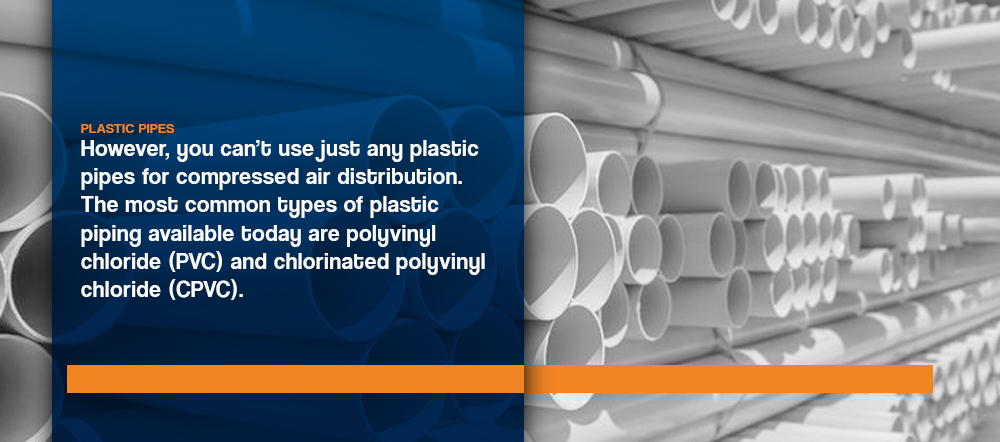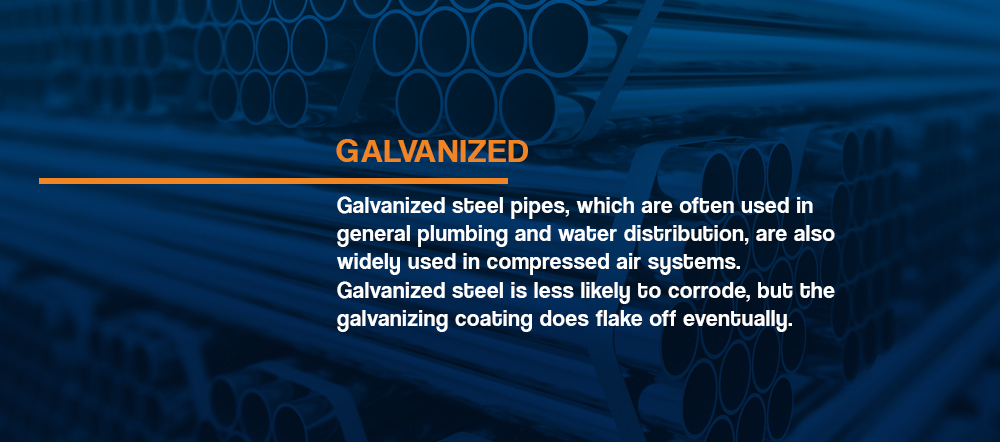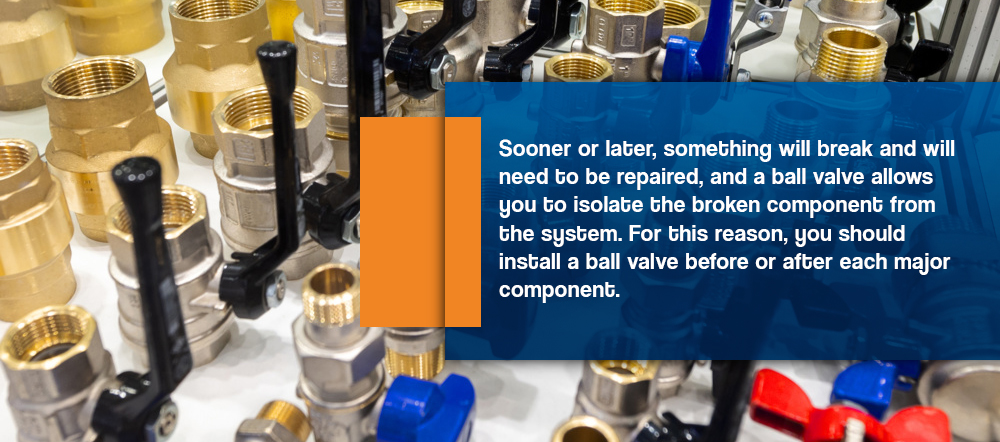
Owners of compressed air piping systems tend to focus on the compressor and think of the piping as less of a concern. However, just as hearts can fail due to clogged arteries, compressors can fail due to poor piping. And even if it doesn’t fail outright, power lost to faulty or inefficient pipes can cut into your profits. To manage your costs, you must pay attention to various aspects of your piping system, including the layout, installation and maintenance.
If you’re planning to design an air compressor piping system, look no further. By reading our handy guide, you’ll learn how air compressor piping systems work, the kinds of pipes you can use and tips on how to make your system more efficient.
How Do Air Compressor Piping Systems Work?
The purpose of compressed air piping systems is simple: to deliver compressed air to where it is needed. However, designing a compressed air system is more difficult than you might imagine — the compressed air has to be delivered with sufficient volume, good enough quality and enough pressure to power the components that require compressed air. If your compressed air piping design is not well done, your energy costs will go up, your equipment may fail, production efficiencies may be reduced and more maintenance may be required.
What Type of Piping Material is Best for Compressed Air?
An essential first question when planning a new compressed air system is, “What type of pipe should I use for my air compressor?” You have two primary options: plastic and metal. Below, we will discuss the advantages and disadvantages of each in detail and address some of the myths that surround each one.
1. Plastic Pipes
Plastic pipes offer many benefits over metal, which include:
- Resistance to corrosion: This means you don’t have to worry about rust falling off your pipes and dropping into your airflow. This, in turn, reduces the risk of obstructions.
- Smooth, interior surface: The interior of a plastic pipe never deteriorates, which encourages laminar flow.
- Lightweight: Plastic piping is lightweight, making it simple to transport and fit.
- Easy to cut: Cutting plastic pipes is easy and only requires basic tools.
- Easy to connect: Plastic pipes can be glued together, which is less costly and quicker than connecting metal pipes, which must be welded together.
However, you can’t use just any plastic pipes for compressed air distribution. The most common types of plastic piping available today are polyvinyl chloride (PVC) and chlorinated polyvinyl chloride (CPVC). These are widely used for plumbing applications, and you may be tempted to use them as they are easy to install, affordable and readily available. However, they cannot withstand the high pressure necessary for a compressed air system.
As is the case with many plastics, PVC becomes brittle with time and is prone to cracking, breaking or even shattering. Furthermore, many air compressors also require lubricating oil that can aspirate out into the air stream, and this oil is corrosive to PVC and CPVC pipes and causes them to degrade. Even worse, the above failures, combined with air under pressure, could create airborne, razor-sharp shrapnel that could be fatal to anyone standing nearby. For all the above reasons, the Occupational Safety and Health Administration (OSHA) has banned the use of PVC for air compressor piping systems, meaning that you could face a steep fine.
The following three plastic materials, however, are all suitable choices for piping compressed air:
- Acrylonitrile butadiene styrene (ABS): You can find ABS in a variety of products, from car fenders to LEGO®-brand toy bricks.
- Polyethylene (PE): This kind of piping is produced specifically for compressed air systems.
- High-density polyethylene (HDPE): This is yet another suitable plastic for compressed air pipes.
OSHA has approved PE, HDPE and ABS for compressed air channels. Unlike PVC, they are all oil-resistant, so compressor lubricants cannot degrade them.
Some people believe that plastic piping for pressurized air isn’t a good idea because the cement used in connectors is not strong enough and will fail, causing bursts and leaks. However, plastic piping manufactured specifically for compressed air systems comes with special cements. These cements are OSHA-tested and -approved and will hold as well and as long as welding on metal pipes.
2. Metal Pipes
Metal pipes have been around for much longer than their plastic equivalents, and traditionalists prefer them when it comes to piping compressed air distribution systems. Just the look and feel of a metal pipe is more substantial and seems to have greater strength than plastic. However advanced plastic piping becomes, some people will always feel safer with metal piping rather than plastic. There are also many benefits of metal pipes when used for air compressor piping systems. These include:
- More well known: Metal is more traditional, which means more technicians know how to install the pipes.
- Longer safety track record: Having been in service longer, metal piping has proven its strength against fracture, splits and blowouts.
- They’re guaranteed not to change shape: While certain plastic materials offer great strength, metal’s inherent rigidity guarantees it won’t warp.
- Impervious to degradation: Compressor lubricants will not degrade metal pipes.
Of course, there are many kinds of metal materials that you can use, and each offers certain pros and cons when used to pipe air compressor systems:
Black Steel
Black steel is the traditional material in compressed air systems and also the material we most recommend. It is readily available, durable and strong, and many fitters can install it. However, keep in mind that, as black steel is uncoated, it is known to produce rust contamination, which could damage pneumatic tooling. While you can control moisture to some extent with a dryer or aftercooler, you will not be able to eliminate it completely.
Suspended pipes need strong anchoring because of how heavy they are. Black steel pipes can also be challenging to cut and join, so installation will take a significant amount of time. In addition, threaded connectors can slip and leak. Although the pipe itself is unlikely to leak, welded joints frequently fail.
Galvanized
Galvanized steel pipes, which are often used in general plumbing and water distribution, are also widely used in compressed air systems. Galvanized steel is less likely to corrode, but the galvanizing coating does flake off eventually. These loose flakes can cause blockages and may do harm when released into the compressed air stream. The debris released can severely damage pneumatic tools, cylinders and other parts. When coming out of a blowgun, this debris can also cause major bodily harm.
Galvanized steel pipes are also difficult to manipulate, and welded or threaded joints tend to fail. They are also heavy, requiring higher strength from suspension and fixing methods. For all the above reasons, we do not recommend galvanized steel pipes for compressed air systems.
Stainless Steel
Stainless steel may be welded or pressed. As with galvanized and black steel, welded or threaded connections tend to fail. Stainless steel won’t degrade or corrode, but it is challenging to install because of its weight. Another drawback is the strength requirements if you’re suspending it from supporting structures. Stainless steel is less common in real-world compressed air applications because of its high cost.
Aluminum
Like stainless steel, aluminum won’t degrade or corrode. However, it weighs much less than stainless, so it’s easy to transport, install and suspend. Aluminum requires similar skills to installing steel pipes, but push-together connectors make it even easier to fit. However, it can be considered expensive.
Copper
Copper pipes are also corrosion-resistant and lightweight. They are easy to cut, weld and suspend. Because copper pipes are often used in plumbing, many fitting types are available and many technicians know how to install them. The color and shininess also make for an aesthetically pleasing look and, as the combination of water and copper does not lead to rusting or corrosion, the air that is delivered to tools through copper pipes is clean and free of debris. However, like aluminum and stainless steel, copper tends to cost more.
Black Iron
Avoid this pipe material. While it was, along with copper, once the go-to material for compressed air installations, black iron is guaranteed to corrode — both on the inside and outside. The corrosion inside the pipe is particularly bad for the quality of your compressed air and your pressure drop.
In compressed air systems, some moisture is inevitable, so the newer pipes from aluminum, copper and stainless steel have become more common than black or galvanized steel pipes. However, these older types are still used in many new installations. They are less expensive, and many installation technicians recommend the materials with which they are most familiar.
Many new customers of compressed air systems are unaware of pressure-grade stainless steel, aluminum and copper pipes. This is often simply because the companies that install pressurized air systems prefer the other options.
Piping Layout Considerations that Increase Pressure Efficiency
When designing a compressed air piping system, you might think you should focus on the connectors. After all, this is where leaks are most likely to occur, and most people assume leaks to be the greatest threat to their system’s efficiency. However, that is not necessarily the case.
The following three factors affect a system’s pressure efficiency more negatively than leaks:
1. Sharp Angles
A sharp angle in your piping system will slow down the airflow, reducing pressure. Think of compressed airflow like the flow of traffic on highways: when turning sharply, you have to slow down. Coming out of a bend requires concentration — you need to correct any overcompensation for the turn and account for any unexpected objects on the new road.
Air is unable to think and steer, so a bend in a piping system causes it to ricochet off the pipe’s interior, which wastes energy. Streamlined airflow is known as “laminar,” whereas a convoluted airflow path is referred to as “turbulent.”
Turbulence leads to a pressure drop, and it will only get worse if the compressor’s output is turned up. Avoid these 90-degree elbow corners as much as possible — otherwise, they’ll lead to turbulence, decreasing the pressure delivery. A straight path in airflow is the most efficient.
The turbulence caused by right-angle bends typically decreases the pressure by 3 to 5 PSID. Therefore, avoid sharp bends and aim for gentler ones ranging from 30 to 45 degrees.
2. Moisture
Water corrodes certain kinds of pipes, causing rust flakes to break off and travel through the piping system. These rust flakes, together with vapor, will make their way into your end-use equipment and may clog up nozzles and contaminate materials that you intend for the compressed air to deliver or apply.
Furthermore, the interior surface of a rusty pipe is rough, which also causes turbulence, further reducing the air pressure.
Moisture is an unavoidable byproduct of air compression. Water resulting from compression comes from air drawn in by your compressor. All ambient air has a certain level of humidity. When that air is compressed, the water in it condenses from its vapor form into a liquid state.
There is a simple way to reduce moisture in the piping system: change the compressor’s supply inlet source. The water resulting from compression weighs more than compressed air, which causes it to sink. If air is drawn in from the compressor’s top, less moisture will be sucked in with it.
While this method can significantly reduce the amount of moisture, an even better approach is to dry the air before it goes inside the compressor. Sucking out moisture mid-stream after the air compression process requires the air to pass through dryers, and this can also reduce the speed of the airflow, which will, in turn, reduce pressure.
To deal with this problem, most compressor installers will recommend the use of an aftercooler. By cooling down the air when it exits the compressor, the moisture will be largely removed before entering your piping system. Roughly two-thirds of the water in compressed air turns into liquid once the air temperature drops to 104 degrees Fahrenheit. To take the liquid out of the system, your aftercooler needs to go into a filter equipped with a drain.
With an aftercooler filter, there will be considerably less moisture in your airflow immediately after leaving the compressor. It’s best to remove moisture early in the process rather than let it circulate in the system.
Coolers, filters and dryers are critical components for compressed air distribution systems. Moisture may be an unavoidable part of compressed air systems, but that does not mean it is acceptable.
3. Obstructions
If a piping system experiences corrosion, this is a cause for concern, as the corroded surface can flake off and accumulate into obstructions. The primary points of restriction in the piping system are where the connectors, valves or devices such as sensors or dryers are located. These components may decrease the pipe diameter through which the air can flow, and they also accumulate particles in the air stream. An accumulation of particulates on these devices will lower pressure available downstream —as well as back up the pressure upstream.
The inevitable particulate content of a compressor’s air intake requires air filters. Just like with dryers, it is better to install good air filters before your compressor — this will remove particles that could clog interior devices and end-use nozzles.
A blockage is not hard to find: you will have excess pressure before it and not enough pressure after it. Many obstructions, however, can be avoided simply by choosing the right pipe materials. By simply opting for a non-corrosive pipe material, you will avoid most obstructions.
Other Considerations
Here are some other things to consider when designing your piping system:
Think About the Future
When designing your layout, make sure that you can expand or make another drop easily. This is easy when you’re first installing, but it can be costly and a major pain to go back and modify later unless your piping system is modular. If you think expansion may be likely, you may want to think about oversizing your pipe. It never hurts to have a bigger pipe and, as mentioned before, it’s a huge hassle to go back and modify your installation.
Install Drip Legs
If your system doesn’t have a membrane, refrigerated or desiccant dryer, you’ll have to install drip legs in the pipe. Remember that compressors squeeze large amounts of water out of the air, and a filter can only remove some of it. Without a dryer, more water will condense inside the pipe, and this water only has two places to go: either back into your compressor or into your equipment, and both of these scenarios will likely lead to damage. A drip leg, however, will allow this water to escape from the pipe without doing any damage to your equipment. Just don’t forget to drain it or put an automatic drain on it. A drip leg is very simple to install, and we recommend it even if you already have a dryer, as it will serve as a backup if your dryer fails.
Install Ball Valves and Unions
Sooner or later, something will break and will need to be repaired, and a ball valve allows you to isolate the broken component from the system. For this reason, you should install a ball valve before or after each major component. We also recommend that you install a union before or after all major components as well as between pipes. If something needs to be changed out, a union can save you many hours of work. Putting in unions can also speed up your installation.
Schedule a Consultation with Quincy Compressor
At Quincy Compressor, we combine legendary performance and reliability. We can help you plan and install a new compressed air piping system or assess your existing system. Contact us to schedule a consultation and find out about the latest technology emerging in piping systems. You can locate a Quincy air compressor distributor or service center near you by using our Sales and Service Locator. Quincy Compressor has been trusted in the market for nearly a century. Let’s work together to maximize your compressed air system’s efficiency.










